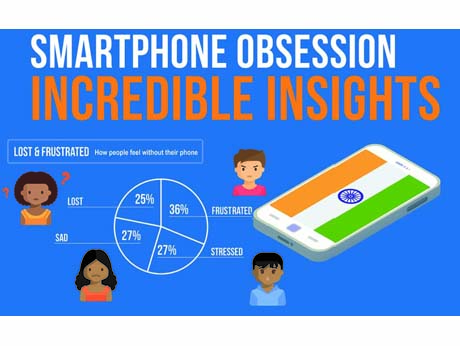
A study by BTX reveals phone obsession of Indians
May 21, 2017: The mobile phone has become an essential accessory for Indians -- they have bought over a billion of them. And if that phone is a smart phone with easy access to Internet and social media, it is almost another limb of the owner.
A new study released by B2X, the Munich, Germany, based leader in customer care solutions for mobile devices and Internet of Things tools, reveals fascinating facts about the extent to which Indians are dependent on their phones, even as the world slowly embraces IoT devices.
Among the India-specific findings are the following:
Here's looking at you! One third of Millennials look at their phone more than 100+ times a day versus 6.7% of Baby Boomers. And more than half of Millennials look at their phone more than 50 times a day, double the rate of Baby Boomers. (GenXor Baby boomer is a term referring to a person who was born between 1946 and 1964, during the so called post world war II baby boom. The millennial generation or Gen Y is the generation of children born between 1982 and 2002-04 and they are likely the children of the baby boomers )
Quality time! 29% of Millennials spend more than 5 hours on their smartphone each day and 6 in 10 Millennials spend at least 3 hours compared to 41.6% of Baby Boomers.
Always on: Consumers are always on call. 85% of global consumers compared to a staggering 92.4% of Indian consumers keep their smartphone in direct reach all the time, and more than a quarter keep it on their body all the time, even at night.
Need for speed. 57% of smartphone users expect friends and family to respond to messages immediately or at least within a few minutes.
Consumers will give up family and friends, even go to prison to not lose their smartphones. Global smartphone users won’t give up their device for one month, even if they were offered a day with their favorite celebrity (74%), a 10% salary increase (56%), an extra week of vacation (50%), $1,000 dollars (41%) or a holiday at their dream destination (28%). India shows similar trend. They would also give up family, friends or sex for a week before their smartphone.
In India, 8% said they would choose to go to prison for one month in order to keep their smartphone for one year, double the number of global consumers.
Finally, consumers regularly feel frustrated (27%), lost (26%), stressed (19%) and sad (16%) without their smartphones.
Consumers are buying more and more expensive smartphones, and consumer IoT devices are going mainstream.
In India, the percentage of people who are planning to pay around Rs 30,000 ( $ 500) will grow from 5.8% to 25.3%, suggests the study.Smartphone customer care, technical capabilities and the quality of materials are the three most frequently mentioned factors for customer satisfaction, globally.
Meanwhile consumer IoT device ownership is expected to grow in the high triple digit percentage range, from 250% for virtual reality headsets to nearly 500% for drones. The two other categories set for highest growth are smart home automation (330%) and smart security systems (275%).Today’s most popular, currently owned IoT devices include GPS devices, Wi-Fi speakers and streaming set-top boxes.
“Gartner estimates that there will be 14 billion IoT devices in use by 2020 plus an additional 6 billion smartphones" , says Dr. Thomas Hess, Director of the Institute for Information Systems and New Media at the Ludwig-Maximilians University of Munich. “People want to connect everything in their lives. They want to automate their home, experience Virtual Reality and use Smart Digital Assistants. And it’s all happening now.”
Customer Care: When it comes to customer care, consumers still want in-store service, fast repairs and in the most highly addicted countries, insurance. The store where consumers bought their smartphone is the most popular option for customer service and support, followed by email. Online support ranks as the third most popular customer service option.
Globally, people find a processing time of 2-3 days acceptable, but in reality, they have to wait 2-3 weeks to get their smartphone repaired.
Speed of service, expertise of staff and transparency of process are the three most important factors for customer satisfaction in smartphone service.
Only 20% of smartphone owners have insurance, but those who do are highly likely to buy it again. Not surprisingly, smartphone insurance is most popular in countries with the highest smartphone addiction. And more than half would like an option for an immediate smartphone replacement.
The Smartphone and IoT Consumer Trends 2017 study was published by B2X in cooperation with Professors Anton Meyer and Thomas Hess from the Institutes of Marketing and New Media at the Ludwig-Maximilians University of Munich. study is based on interviews of more than 2,600 people in Brazil, Germany, India, Russia and the United States conducted by Facit Research in cooperation with Professors Meyer and Hess.